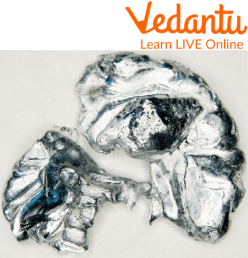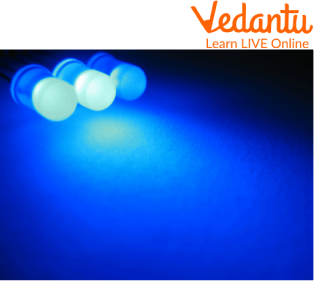




Overview of Gallium
The periodic table is a system for grouping chemical elements. All matter is composed of fundamental components known as chemical elements. Every chemical element has a unique property known as an element's atomic number. Each atom of the element contains a certain number of protons, which are tiny particles. The elements are arranged in rows and columns on the periodic table according to their atomic number and chemical properties, respectively.

Crystals of Gallium Joined Together
Today we will study an element which has some unusual properties. If I place that element in your hand, it will melt. Can you guess the name of such an element? The element is Gallium. Gallium is derived from the Latin word Gallia, meaning ‘Gaul’. Lecoq de Boisbaudran was the one who discovered gallium in 1875.
In this article, we will learn about this element and its many properties. The uses and characteristics of gallium are also discussed in this article. So, without wasting time, let’s dive in!

Gallium Melting in Hands
Gallium in the Periodic Table
Gallium is classified in group 13 as the third element in the periodic table. It is categorised as "other" metal or post-transition metal. An atom of gallium has 31 protons, 31 electrons, and 3 valence electrons in the outer shell. Further, we will learn about gallium's melting point, boiling point of gallium, uses of gallium, and interesting facts about gallium.
Characteristics and Properties of Gallium
The characteristics and properties of Gallium are as follows:
Gallium Symbol: Ga
Gallium Atomic Number: 31
Atomic Weight: 69.723
Classification: Post-transition or "other" metal
Phase at Room Temperature: Solid
Density: 5.91 grams per cm cubed
Melting Point: 29.76°C or 85.57°F
Boiling Point: 2204°C or 3999°F
Isotopes: Gallium-69 and Gallium-71
Gallium is a soft and brittle metal which can be broken easily, like glass. It is shiny and silvery. The low melting and high boiling points of gallium are among its interesting characteristics. Because of its high melting point, it is solid at normal temperatures but melts in your hand.
Gallium expands by 3.1 per cent upon freezing or solidifies (like water freezes into ice). Due to the expansion that occurs as the temperature drops, you must be careful when keeping liquid gallium. It should not be stored in either glass or metal containers. A relatively reactive element, gallium interacts easily with both acids and alkalis. Usually, it is found in a +3 oxidation state.

Gallium-based Blue LEDs
Gallium is a semiconductor as it does not conduct electricity; therefore, it is used in computers to make them work. It is not found in its elemental form on earth, but it is produced as a byproduct of mining other metals, including aluminium and zinc.
Uses of Gallium
The uses of gallium are as follows
Gallium is used in some high-temperature thermometers.
Gallium can create brilliant mirrors as it wets glass and porcelain.
Gallium is commonly used to dope semiconductors and create solid-state electronics like transistors.
A liquid gallium-tin alloy could replace water-based computer chip cooling.
In medical imaging, gallium salts are used as radiocontrast materials.
Interesting Facts about Gallium
Some interesting facts about Gallium are listed below:
The Neutrino Observatory in Italy uses a lot of gallium to research the solar neutrinos created inside the Sun.
It is not used by either plants or animals and is thought to be non-toxic.
Laser diodes, which generate light from electricity, are made from gallium arsenide. For long-distance data transmission, this is preferred over fibre optics.
Bright blue LEDs are made from gallium.
Solar panels made of gallium are used to power space applications such as satellites and Mars rover missions.
The abundance of gallium in the crust of the Earth is 19 parts per million, making it the 34th most prevalent element there.
During World War II, gallium was initially acknowledged as a crucial mineral resource and used in the core of the first atomic weapon to assist stabilise the crystal structure of plutonium in an alloy created as part of the Manhattan Project.
Summary
Element Gallium is derived from the Latin word Gallia meaning 'Gaul'. An atom of gallium has 31 protons, 31 electrons, and 3 valence electrons in the outer shell. The melting point and boiling point of gallium are 29.76°C, 85.57°F and 2204°C, 3999°F respectively. With a weight abundance of 40 parts per billion, gallium is abundant in our solar system.
It is commonly employed in the production of solid-state electronics, including transistors and semiconductor doping. Solar panels of gallium are used to power space applications such as satellites and Mars rovers.
FAQs on Classification of Gallium and Its Properties
1. How is gallium classified in the periodic table?
Gallium (Ga) is classified as a post-transition metal in the periodic table. It is located in Group 13 and Period 4, as part of the p-block elements. Its atomic number is 31. This places it alongside other elements like aluminium and indium, with which it shares several properties.
2. What are the main physical properties of gallium?
Gallium is known for its unique physical properties. The most important ones for students to know are:
Appearance: It is a soft, silvery-white metal that can be cut with a knife.
Low Melting Point: It has an unusually low melting point of about 29.76 °C (85.58 °F), which means it can melt in a person's hand.
High Boiling Point: Despite its low melting point, it has a very high boiling point of 2403 °C (4357 °F), giving it one of the largest liquid ranges of any element.
Density Anomaly: Like water, it is one of the few substances that expands when it freezes, so it should not be stored in glass or metal containers.
3. What are the important chemical properties of gallium?
Gallium's chemical properties are primarily determined by its three valence electrons. It is an amphoteric element, meaning it reacts with both acids and strong bases. It typically forms compounds in the +3 oxidation state. For example, it reacts with halogens to form gallium trihalides (like GaCl₃) and dissolves in acids to form gallium(III) salts.
4. Why does gallium have such a low melting point, allowing it to melt in your hand?
Gallium's remarkably low melting point is due to its unusual crystal structure. In solid form, gallium atoms pair up to form Ga₂ molecules. The bonds within these molecules are strong (covalent), but the bonds holding the different molecules together are very weak. When heated slightly, these weak intermolecular forces break easily, causing the solid to melt into a liquid. This is different from most metals, which have a uniform, strong metallic bonding throughout their structure.
5. What does it mean for gallium to be an amphoteric element?
An amphoteric element is one that can react chemically as both an acid and a base. Gallium demonstrates this property perfectly.
When reacting with an acid like hydrochloric acid (HCl), it acts as a base to form a gallium salt: 2Ga + 6HCl → 2GaCl₃ + 3H₂.
When reacting with a strong base like sodium hydroxide (NaOH), it acts as an acid to form sodium gallate: 2Ga + 2NaOH + 6H₂O → 2Na[Ga(OH)₄] + 3H₂.
6. What are the most common uses of gallium in modern technology?
Gallium is a critical element in modern electronics and technology, primarily used in compound form. Key applications include:
Semiconductors: Gallium arsenide (GaAs) and gallium nitride (GaN) are vital semiconductors used in high-frequency integrated circuits, smartphones, and LEDs.
LEDs: Blue and violet LEDs (Light Emitting Diodes) are made using gallium nitride, a technology that revolutionised lighting and displays.
Thermometers: Due to its low toxicity and high boiling point, a gallium alloy called Galinstan is used as a non-toxic replacement for mercury in thermometers.
Alloys: It is used to create low-melting-point alloys for applications like fire sprinkler systems and heat-sensitive fuses.
7. How does gallium's electronic configuration influence its chemical behaviour?
Gallium's electronic configuration is [Ar] 3d¹⁰ 4s² 4p¹. Its chemical behaviour is dominated by the three electrons in its outermost shell (the 4s and 4p orbitals). To achieve stability, gallium typically loses these three valence electrons to form the Ga³⁺ ion, leading to its common +3 oxidation state. The filled 3d¹⁰ subshell shields the nuclear charge somewhat ineffectively, which influences its atomic radius and ionization energies compared to aluminium.
8. Is gallium safe to handle, and what precautions should be taken?
Pure metallic gallium is considered to have low toxicity and is generally safe to handle for short periods. However, it can leave a temporary, non-toxic grey stain on the skin. The main precaution is to avoid ingestion. While the metal itself is safe, some of its compounds, like gallium arsenide (GaAs), are toxic and should only be handled by professionals in controlled environments. As a standard practice, it is always best to wash your hands after handling any chemical element.









